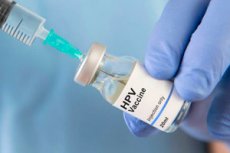
Cervical cancer is the most common type of female cancer caused by the human papillomavirus (HPV).
It is the fourth most common cancer among women worldwide, with approximately 660,000 new cases and approximately 350,000 deaths expected in 2022.
According to the US Centers for Disease Control and Prevention (CDC), every year about 200,000 women in the country are diagnosed with precancerous conditions of the cervix. About 11,100 women are diagnosed with cervical cancer caused by HPV, and approximately 4,000 women die from the disease each year. HPV infections usually clear up within one or two years.
However, some strains of HPV can cause cancer in both men and women, leading to 36,000 cases of cancer each year. Almost everyone will become infected with some strain of HPV during their lifetime, according to the CDC.
There is an HPV vaccine that can prevent more than 90% of cancers associated with this virus. In 2022, however, only 38.6% of young adults in the US have received at least one of the two recommended doses of the vaccine. Despite the risks associated with HPV for both sexes, girls are more likely to be vaccinated against it than boys.
A new study finds that HPV vaccination can reduce the risk of HPV-related cancers by 56% in men and 36% in women.
These results were presented at the annual meeting of the American Society of Clinical Oncology from May 31 to June 4 in Chicago, but have not yet been published in a peer-reviewed scientific journal.
Daniel Ganjian, MD, a board-certified pediatrician at St. John's Medical Center in Santa Monica, California, who was not involved in the study, explained:
"The incidence of cancer caused by HPV in men is significant. According to the CDC, about 4 out of every 10 cancers caused by HPV occur in men, and more than 15,000 men are diagnosed with cancer caused by HPV each year in the United States. HPV can cause cancer in both women and men, with HPV-related throat cancer being more common in men and increasing rapidly in developed countries.
The effectiveness of the HPV vaccine in preventing cancer
In women, the HPV virus is associated with the development of cancer of the cervix, vagina and vulva. In men, HPV is associated with penile cancer. In both sexes, HPV can lead to cancer of the throat and anal canal.
The HPV vaccine can prevent more than 90% of precancerous lesions of the vagina, cervix and vulva, which include abnormal cells that can lead to cancer in the future.
Authors of the new study compared about 1.7 million people vaccinated against HPV with a similarly sized and age-matched group that did not receive the vaccine.
The researchers found that among vaccinated men there were 3.4 cases of HPV-related cancer per 100,000 people, while among unvaccinated men the rate was 7.5 cases per 100,000 people.
For women, the difference was also significant: among vaccinated women there were 11.5 cases of HPV-related cancer per 100,000 people, and among unvaccinated women there were 15.8 cases per 100,000 people.
Rachel Goldberg, a Los Angeles internist who was not involved in the study, commented on HPV vaccines:
“For decades, women have been told about the importance of Pap tests to detect early signs of disease,” she said.
"Most women know at least one person who has had a minor procedure to remove abnormal cells thought to be associated with HPV. Often this is a woman in her 20s or 30s," Goldberg added.
Goldberg also noted an increase in HPV-related cancers among men, especially those aged 40 to 60.
Why is it important to increase HPV vaccination among children?
The CDC recommends that children receive two doses of the HPV vaccine starting at age 11 or 12, although vaccination can begin as early as age 9.
For children who do not receive their first HPV vaccine before age 15, three doses are required for optimal protection.
"It is important to note that the HPV vaccine prevents new HPV infections, but does not cure existing infections or diseases. The vaccine works best when given before any exposure to HPV," Ganjian said.
Goldberg noted that some parents may delay vaccinating their children against HPV because they believe they are not yet sexually active.
"Over time, parents may believe that it is too late, their child is leaving their care, or they believe that it will not affect their child due to his [or her] level of responsibility, without realizing how much HPV spreads easily," Goldberg explained.
"The value of the HPV vaccine for men is known among physicians, but awareness and vaccination rates among men remain low," Ganjian said.
Goldberg also noted other misconceptions that may contribute to HPV stigma among young men.
"It is still primarily seen as a protective measure for girls, with some parents believing that vaccinating their sons is only needed to protect their potential future partners," Goldberg added.
Demographic and social differences influence HPV vaccination rates
CDC statistics show that demographic characteristics may determine whether a child will be vaccinated against HPV.
For example, vaccination rates increase as children age and are more common in families of higher socioeconomic status. In addition, children with disabilities are more likely to receive vaccinations than children without disabilities.
Vaccination is less likely among Hispanic children compared to white children. Additionally, children living outside urban areas are less likely to receive the HPV vaccine.
"Research shows that there are racial and ethnic disparities in knowledge about the HPV vaccine and trust in receiving cancer information from doctors," Ganjian said.
"This may contribute to fewer boys receiving the vaccine. Additionally, physician communication practices and the level of trust in cancer information from physicians may influence awareness of the HPV vaccine," he concluded.

